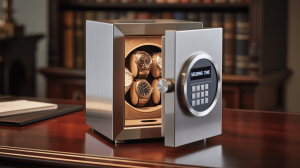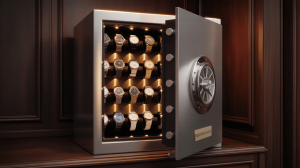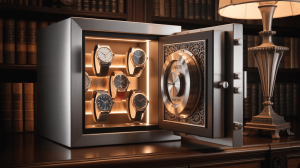Safe for Watches: Keeping Your Timepieces Secure and Organized. But here’s the kicker… Your watches deserve more than a drawer—they need a purpose‑built safe that combines theft deterrence, fire protection, climate control, and modular organization to preserve both value and condition.
1. Assessing Security Threats
Understand local burglary rates and evaluate home entry points. Certified UL RSC or ETL burglary ratings confirm resistance to prying, drilling, and forced entry. Choose heavy‑gauge steel walls and multi‑bolt locking systems. Mechanical dials never fail for lack of power; electronic keypads offer multiple codes and time delays; biometric scanners grant fingerprint‑level security. Concealed anchor points let you bolt the safe to floors or cabinets, making removal virtually impossible.
| Security Feature | Specification | Benefit |
|---|---|---|
| Burglary Rating | UL RSC/ETL certified | Proven forced‑entry resistance |
| Lock Type | Dial, keypad, biometric | Tailored access control |
| Anchor Points | Floor/furniture mounting | Prevents theft by removal |
2. Fire and Heat Resistance Essentials
Fires can engulf homes quickly, pushing temperatures beyond safe thresholds. UL 72 Class 350 ratings guarantee 30–60 minutes of internal protection at up to 1,200–1,400 °F. Gypsum or ceramic composite interiors block heat transfer, while intumescent gaskets expand under flame to seal door seams. This combination preserves lubricants, gaskets, and delicate movements inside the safe.
3. Measuring Capacity for Current and Future Needs
Each watch on a pillow needs roughly 2 inches width and 1.5 inches height clearance. Account for extra storage—straps, tools, and paperwork—by adding 20–30% more space. Compact safes (6×8×6 inches) secure 2–4 watches; medium (8×10×8) hold 4–6; larger units (10×12×8) fit 6–10. Modular trays or foam inserts allow you to reconfigure interiors as your collection grows, preventing overcrowding and scratches.
4. Exterior Materials and Aesthetic Options
Your safe’s outer shell should complement décor. Powder‑coat steel in matte black blends seamlessly, while brushed stainless steel adds modern shine. Wood veneers—walnut, oak—or leather wraps in custom colors bring warmth. Choose corrosion‑resistant hardware and concealed hinges to maintain both function and style.
| Material Option | Durability | Visual Appeal |
|---|---|---|
| Powder‑Coat Steel | Scratch and corrosion‑resistant | Matte stealth look |
| Stainless Steel | High rigidity and shine | Contemporary elegance |
| Wood Veneer/Leather | Decorative surface | High‑end luxury finish |
5. Selecting the Perfect Locking Mechanism
Mechanical dials work without power but require manual rotation. Electronic keypads enable multiple user codes, time‑delay features, and audit logs. Biometric scanners unlock in seconds via fingerprint but need periodic re‑registration. Dual‑lock setups combine methods—keypad plus dial or biometric plus key—for layered security, deterring both casual and professional thieves.
6. Integrating Watch Winder Functionality
For automatic watches, built‑in winders save manual winding. Look for adjustable turns‑per‑day (TPD) settings, directional control (clockwise, counterclockwise, or bi‑directional), and motors rated under 25 dB for silent operation. Pause intervals prevent over‑winding. Removable winder trays convert to static storage when not needed.
7. Interior Organization Strategies
A well‑organized safe protects and showcases your collection. Use foam or velvet‑lined pillows that conform to case shapes. Adjustable trays and removable dividers let you configure compartments for varied watch sizes and accessories. Hidden pockets beneath trays store straps, spring bars, and cleaning tools out of sight.
| Organizer Component | Purpose | Advantage |
|---|---|---|
| Foam/V velvet Pillows | Cradle individual watches | Prevents movement and scratches |
| Adjustable Trays | Custom compartment layout | Flexible organization |
| Hidden Pockets | Store small accessories | Keeps tools and cards tidy |
8. Climate and Humidity Control Features
Humidity and dust threaten mechanical movements and leather straps. Opt for door gaskets rated IP54 or higher to block dust and moisture. Desiccant packs or built‑in silica gel chambers maintain relative humidity below 50%. Premium safes include digital hygrometers for real‑time monitoring and active dehumidifiers for precise environmental control.
9. Noise and Vibration Mitigation
Excessive noise or vibration can damage delicate gears. Seek safes with rubber‑damped motor mounts, precision bearings, and low‑noise motors under 25 dB. Soft‑close hinges and silent bolt engagement prevent slams and clicks. These features ensure your safe operates quietly in bedrooms or offices without disturbing the environment.
10. Smart Connectivity and Remote Monitoring
Enhance security with Bluetooth or Wi‑Fi integration. Mobile apps deliver tamper, door‑open, and low‑battery alerts in real time. Remote lock/unlock, digital audit logs, and TPD adjustments for winders provide convenience and oversight, whether at home or traveling.
| Connectivity Feature | Functionality | Benefit |
|---|---|---|
| Tamper Alerts | Immediate notifications | Quick response |
| Remote Lock/Unlock | App‑based control | Convenience |
| Audit Logs | Access history | Enhanced accountability |
11. Power and Backup Solutions
Electronic locks and winders need reliable power. Choose safes offering dual‑power—AC adapters for continuous use and rechargeable battery packs as backup. Low‑battery alerts via LED or app prevent unexpected shutdowns. Always keep a concealed manual override key or mechanical dial to ensure access during power failures.
12. Installation and Anchoring Best Practices
Even the best safe fails if it’s portable. Bolt to floor joists or wall studs using heavy‑duty anchors included by the manufacturer. Conceal anchor points under interior lining or decorative panels to maintain aesthetics. Test stability by gently attempting to lift or pry—proper anchoring transforms the safe into an immovable fortress.
13. Matching Style to Your Environment
Your watch safe should feel like furniture, not an industrial box. Slim profiles fit under nightstands or inside cabinets. Matte finishes suit minimalist décor; wood veneers or leather wraps complement traditional interiors. Custom color or engraving options let you personalize the safe as a design feature.
14. Budgeting for Essential Features
Safes range from entry‑level ($100–$300) with basic security and key locks, to mid‑range ($300–$700) adding fire ratings, electronic locks, and climate control, to premium ($700+) featuring biometrics, smart apps, winders, and luxury finishes. Prioritize certifications—burglary and fire ratings—alongside interior organization and climate features before splurging on aesthetics.
| Price Tier | Core Features | Ideal Buyer |
|---|---|---|
| $100–$300 | Steel shell, key lock | Casual collectors |
| $300–$700 | Fire rating, keypad, humid control | Enthusiasts |
| $700+ | Biometric, smart, winders | High‑end collectors |
15. Warranty, Support, and Maintenance
A solid warranty underscores manufacturer confidence. Seek 2–5 year coverage for both safe body and electronics. Onsite service options and spare‑part availability ensure quick repairs. Maintain your safe with monthly dusting, quarterly lock tests, battery checks, and annual desiccant replacement to guarantee longevity.
Conclusion
A watch safe that combines security with organization safeguards your investment while complementing your décor. Ready for the good part? Leverage this guide to choose a certified, feature‑rich safe that keeps your timepieces secure, climate‑controlled, and impeccably organized.
FAQ
Q1: What burglary rating is recommended?
Aim for UL RSC or ETL certification for verified forced‑entry resistance.
Q2: How often replace desiccant packs?
Replace every 6–12 months based on humidity levels.
Q3: Are biometric locks reliable?
Yes—premium scanners include encrypted templates plus backup options.
Q4: Do smart features require subscriptions?
Basic app control is usually free; advanced monitoring may incur fees.
Q5: Is professional installation necessary?
DIY anchoring to studs is possible—ensure you follow manufacturer guidelines.







